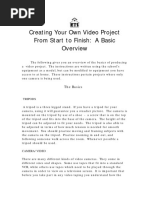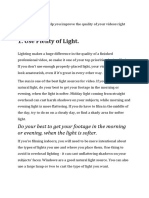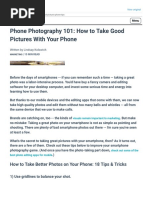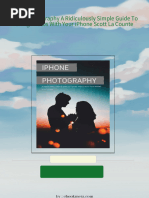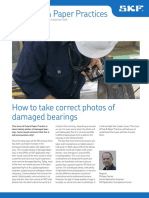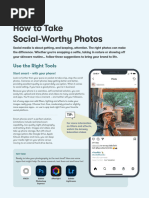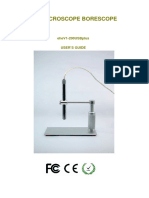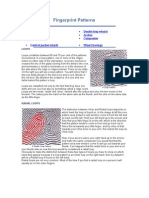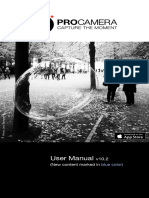0 ratings0% found this document useful (0 votes)
33 viewsPre-Read Video Making
Pre-Read Video Making
Uploaded by
Ashutosh PatidarThis document provides tips for making videos using a cellphone. It begins by explaining that modern phones allow users to capture high quality images. It then lists 11 tips for cellphone filmmaking, including determining what to shoot, using landscape vs portrait orientation, staying steady, using lighting effectively, posing subjects, composition, using the grid, zooming vs not zooming, managing audio, and editing footage. The overall message is that following these tips and working as a team can help produce good visual narratives using a cellphone.
Copyright:
© All Rights Reserved
Available Formats
Download as PDF, TXT or read online from Scribd
Pre-Read Video Making
Pre-Read Video Making
Uploaded by
Ashutosh Patidar0 ratings0% found this document useful (0 votes)
33 views4 pagesThis document provides tips for making videos using a cellphone. It begins by explaining that modern phones allow users to capture high quality images. It then lists 11 tips for cellphone filmmaking, including determining what to shoot, using landscape vs portrait orientation, staying steady, using lighting effectively, posing subjects, composition, using the grid, zooming vs not zooming, managing audio, and editing footage. The overall message is that following these tips and working as a team can help produce good visual narratives using a cellphone.
Original Title
Pre-Read Video making
Copyright
© © All Rights Reserved
Available Formats
PDF, TXT or read online from Scribd
Share this document
Did you find this document useful?
Is this content inappropriate?
This document provides tips for making videos using a cellphone. It begins by explaining that modern phones allow users to capture high quality images. It then lists 11 tips for cellphone filmmaking, including determining what to shoot, using landscape vs portrait orientation, staying steady, using lighting effectively, posing subjects, composition, using the grid, zooming vs not zooming, managing audio, and editing footage. The overall message is that following these tips and working as a team can help produce good visual narratives using a cellphone.
Copyright:
© All Rights Reserved
Available Formats
Download as PDF, TXT or read online from Scribd
Download as pdf or txt
0 ratings0% found this document useful (0 votes)
33 views4 pagesPre-Read Video Making
Pre-Read Video Making
Uploaded by
Ashutosh PatidarThis document provides tips for making videos using a cellphone. It begins by explaining that modern phones allow users to capture high quality images. It then lists 11 tips for cellphone filmmaking, including determining what to shoot, using landscape vs portrait orientation, staying steady, using lighting effectively, posing subjects, composition, using the grid, zooming vs not zooming, managing audio, and editing footage. The overall message is that following these tips and working as a team can help produce good visual narratives using a cellphone.
Copyright:
© All Rights Reserved
Available Formats
Download as PDF, TXT or read online from Scribd
Download as pdf or txt
You are on page 1of 4
CELLPHONE FILM MAKING
Today, the modern phones give us the technological
advantages to get the images right. Capturing is more or less
taken care of. Most of the time, the task is to make what you
capture ‘speak’ in the right tone.
By the end of this effort, the videos you make should convey
information, and create a response in the viewer.
Understanding the dimensions in the way you work will make
you confident, and that will refine your interpretative style.
You can make a video to tell a story, a business idea, or a
video of yourself which will become your CV.
Use the following tips to make better looking videos using
your phone.
TIP 10 DETERMINE WHAT TO SHOOT
Depending on the task you have, you might need an interview,
documentation of activities,
Do you need permissions? Obtain if necessary.
If interviewing, define your team functions- who will shoot,
who will take notes, who will talk to the subjects etc.
TIP 9 LANDSCAPE VS PORTRAIT
Vertical frame was not practical for a film or video as the
reproduction was always in a horizontal format. In a
photograph, the print could be in vertical also, based on
context. This tradition restricts phone users also to hold the
camera or the view horizontally.
TIP 8 STAY STEADY
This looks like the simplest tip. Keep phone closer to your
body. If you have a phone stand, nothing like it. But you can
make good work without a stand also. Take care while
breathing.
TIP 7 LIGHT
There is no right or wrong light. When it comes to electronics,
like sensors and optics, in cameras and phones, light or lack
of light can cause electronic disturbances which we call grains.
Today’s cameras are very well advanced to make use of
available light, to make things extremely easy.
Try as much as possible to shoot your subjects in brightly lit
areas. Shadows and electronic disturbances could be avoided
by this.
One common problem while shooting is the position of light
source. If the light source is behind the subject, the subject
will look darker, for which naturally we adjust the overall
brightness. This could create imbalance in light. By changing
the positing of the camera, this could be adjusted.
If there is an issue with light sources, a second phone with
torch on could be used as a saver (not by pointing at the
subject’s face directly to scare). The torch light could be
bounced back at the subject too.
TIP 6 POSING YOUR SUBJECT
Have you got their consent? This is mandatory to tell them
how this might be used for, why you are doing it etc, before
they ask you. This creates a rapport with your subject.
The best poses are usually when your subject adopt
voluntarily. If they are waiting for your ‘direction’, encourage
them to go on natural.
Usually the question ‘where do I look when I talk’ is answered
as ‘please look at the camera lens’. This could be confusing to
some, to make them nervous. If they manage to speak to the
lens, great, else let your crew member stand behind in the
same level and let the subject talk to her.
TIP 5 COMPOSITION
This tip is with reference to ‘what you want your viewer to
see’. Sometimes you are restricted in where you can stand
while shooting. When your viewer sees your video, he might
see a back ground, or a foreground in the context of your
subject. Playing with this, focusing on the subject, gives
tremendous options to portray subject in focus.
You can lead the eyes of the viewer in the frame: Lines can
lead. Texture can lead.
TIP 4 USE THE GRID
Grid in your camera helps to decide framing your subject. In
composition, applying rule of thirds is a very effective
aesthetic measure. Once the image is divided into 2 horizontal
and 2 vertical lines, subject(s) could be composed using the
divided columns of intersecting points. This results in creating
compositions challenging to eyes, rather than at the center of
the frame. Keep your camera with grid option on.
TIP 3 ZOOM OR NO-ZOOM
In photography class or cinematography class, one tries to
learn not to use a zoom! This is to get used to a field of view
similar to the field of view of a single human eye. In phone
cameras, when you zoom, the electronics demands a much
steadier hand to keep your image shaky. So, if you want to
show your subject larger, go closer.
Going closer to subject will get a better sound also.
TIP 2 AUDIO
Usually live audio is recorded by specialists. In the context,
live audio could be recorded along with video. If you use an
external microphone, it records very well. If using the phone
mic itself, care should be taken about ambient sounds. There
could be a bird sound or traffic sound while you try to record
your subject’s voice. One team member paying attention to
only sound during the action could be of some help.
TIP 1 EDIT
After the shoot, we need to edit the footage.
Step 1 is to analyze the footage. Review it in the team.
Maintain a log to capture your observations which are relevant.
A good organized log will help to finish the work fast.
Step 2 is to crop and combine the footage which are needed.
There are many phone apps which allow you to do this in the
phone, like filmora, vivavideo, videotrim etc.
In windows, we have video editor which can crop, add music
and share.
In iOS, there is iMovie which is a very easy application.
The secret to the good visual narrative outcomes is the
smooth blend of a teamwork and appropriate techniques.
All the best.
You might also like
- Club Life Design WorkbookDocument31 pagesClub Life Design WorkbookCristiana AntunesNo ratings yet
- PrimalVideo-iPhone Filming GuideDocument7 pagesPrimalVideo-iPhone Filming GuidehafizurahmanNo ratings yet
- Master Mobile Photography Preview PDFDocument28 pagesMaster Mobile Photography Preview PDFMohit Jani100% (5)
- Comprehensive OphthalmologyDocument1 pageComprehensive OphthalmologyArdianNo ratings yet
- PCB00 ZCB00 Brochure PDFDocument16 pagesPCB00 ZCB00 Brochure PDFManuelNo ratings yet
- CreateyourownDocument15 pagesCreateyourownVid BegićNo ratings yet
- 15 Tips On How To Improve Your Iphone PhotographyDocument10 pages15 Tips On How To Improve Your Iphone PhotographyKristen DeArmasNo ratings yet
- DIY Library Program Phone PhotographyDocument10 pagesDIY Library Program Phone PhotographyDhirendra YadavNo ratings yet
- Use Plenty of Light.: Do Your Best To Get Your Footage in The Morning or Evening, When The Light Is SofterDocument14 pagesUse Plenty of Light.: Do Your Best To Get Your Footage in The Morning or Evening, When The Light Is SofterXtin ClaraNo ratings yet
- Ict 10 Learners Notes 1Document4 pagesIct 10 Learners Notes 1setariryeNo ratings yet
- BEGINNER Video EditingDocument10 pagesBEGINNER Video EditingRommel DesuyoNo ratings yet
- Steps The: MistakesDocument6 pagesSteps The: MistakesvamcareerNo ratings yet
- Complete Mobile Photography CourseDocument13 pagesComplete Mobile Photography CourseScribdTranslationsNo ratings yet
- 6 Advanced Iphone Camera Controls For Jaw-Dropping PhotographyDocument6 pages6 Advanced Iphone Camera Controls For Jaw-Dropping PhotographyFelipe Felipe0% (2)
- How To Shoot Great Video For Your Business: INTERNET ENTREPRENEUR UNDER THE SPOTLIGHT SERIES, #3From EverandHow To Shoot Great Video For Your Business: INTERNET ENTREPRENEUR UNDER THE SPOTLIGHT SERIES, #3No ratings yet
- Become A Creator WorkshopDocument42 pagesBecome A Creator WorkshopVisual Story AgencyNo ratings yet
- Module 3 Lesson 1 PDFDocument20 pagesModule 3 Lesson 1 PDFPaulet M.No ratings yet
- 10 Camera Settings: and Tips For Portrait PhotographyDocument32 pages10 Camera Settings: and Tips For Portrait Photographyasafoabe4065100% (1)
- AVP - Single Camera Interview PDFDocument25 pagesAVP - Single Camera Interview PDFKen MorrisonNo ratings yet
- Unit-4 Mobile JournalismDocument5 pagesUnit-4 Mobile JournalismsandyanaikNo ratings yet
- 50 Things Photographers Need to Know About Focus: An Enthusiast's GuideFrom Everand50 Things Photographers Need to Know About Focus: An Enthusiast's GuideNo ratings yet
- The Enthusiast's Guide to iPhone Photography: 63 Photographic Principles You Need to KnowFrom EverandThe Enthusiast's Guide to iPhone Photography: 63 Photographic Principles You Need to KnowNo ratings yet
- How To Take Good Pictures With Your PhoneDocument17 pagesHow To Take Good Pictures With Your PhonehiNo ratings yet
- Full Download iPhone Photography A Ridiculously Simple Guide To Taking Photos With Your iPhone Scott La Counte PDF DOCXDocument55 pagesFull Download iPhone Photography A Ridiculously Simple Guide To Taking Photos With Your iPhone Scott La Counte PDF DOCXbanbootonnieNo ratings yet
- Smartphone Video Production: Tips & GuidelinesDocument2 pagesSmartphone Video Production: Tips & GuidelinesAhmad Azim HazimiNo ratings yet
- Visual Media - PhotographyDocument6 pagesVisual Media - PhotographyMary Dorothy Anne OmalNo ratings yet
- 5 Photography Techniques Everyone Should Know: CamerasDocument5 pages5 Photography Techniques Everyone Should Know: Camerasmhk665No ratings yet
- PrimalVideo-Android Filming GuideDocument6 pagesPrimalVideo-Android Filming GuideyaltribianaNo ratings yet
- Smartphone Photography Guide PDFDocument46 pagesSmartphone Photography Guide PDFBhuwan SNo ratings yet
- BVCLS Lab ManualDocument18 pagesBVCLS Lab Manualsuhanikhanna1622No ratings yet
- photographyDocument42 pagesphotographyAileen CañaNo ratings yet
- Short Guide To Digital Photography in ArchaeologyDocument16 pagesShort Guide To Digital Photography in ArchaeologyDavid Connolly100% (14)
- Videography GuideDocument8 pagesVideography GuideSyed Jawwad ul hasanNo ratings yet
- Video School / Lesson: Behind The SceneDocument39 pagesVideo School / Lesson: Behind The SceneRegi FiandisaNo ratings yet
- BAJMC Video Production Practical FileDocument27 pagesBAJMC Video Production Practical FileNaman jainNo ratings yet
- SKF Pulp and Paper PracticesDocument24 pagesSKF Pulp and Paper PracticesSanjeevi Kumar SpNo ratings yet
- DigitalPhotography PDFDocument16 pagesDigitalPhotography PDFFulagnilNo ratings yet
- Macro Photography For AmateurDocument94 pagesMacro Photography For AmateurNymphNo ratings yet
- Mobile PhotographyDocument71 pagesMobile PhotographynaZarNo ratings yet
- Digital Photography: The Ultimate Guide For Fast Mastering Aperture, Shutter Speed, Iso and ExposureFrom EverandDigital Photography: The Ultimate Guide For Fast Mastering Aperture, Shutter Speed, Iso and ExposureRating: 4 out of 5 stars4/5 (1)
- Social Worthy PhotosDocument7 pagesSocial Worthy PhotosSteve JobNo ratings yet
- Digital SLR Guide: How to get the most out of your digital camera, including lighting, shutter speed, aperture, exposure, photography basics and more!From EverandDigital SLR Guide: How to get the most out of your digital camera, including lighting, shutter speed, aperture, exposure, photography basics and more!No ratings yet
- How To Take Those Really Long Iphone Screenshots - CNETDocument1 pageHow To Take Those Really Long Iphone Screenshots - CNETsukontoraharjoNo ratings yet
- Parts of A CameraDocument13 pagesParts of A CameradhaniloNo ratings yet
- Ehev1 200USBplusDocument13 pagesEhev1 200USBplusAndré LuizNo ratings yet
- Scott La Counte - Iphone Photography - A Ridiculously Simple Guide To Taking Photos With Your iPhone-SL Editions (2019) (Z-Lib - Io)Document94 pagesScott La Counte - Iphone Photography - A Ridiculously Simple Guide To Taking Photos With Your iPhone-SL Editions (2019) (Z-Lib - Io)shams31No ratings yet
- Mobile Photography GuideDocument48 pagesMobile Photography GuideAvid Rollick SeptianaNo ratings yet
- Making A Welcome VideoDocument3 pagesMaking A Welcome Videoagfteam.24No ratings yet
- MODULE 8 & 9 Living in the IT ERADocument12 pagesMODULE 8 & 9 Living in the IT ERAEvany LofrancoNo ratings yet
- Picture Perfect Squad AcademyDocument10 pagesPicture Perfect Squad AcademyaphraxNo ratings yet
- 03 Laboratory Exercise 1Document4 pages03 Laboratory Exercise 1youare3ternalNo ratings yet
- 13 Tips For Improving Camera Phone PhotosDocument3 pages13 Tips For Improving Camera Phone PhotosAndrei RaduNo ratings yet
- Point and ShootDocument28 pagesPoint and ShootAlikatuNo ratings yet
- COMPUTER 7 Handout 5Document8 pagesCOMPUTER 7 Handout 5Agnes Agustin (AA)No ratings yet
- IphonDocument17 pagesIphonpristineshopperNo ratings yet
- Simple Tips For Better PortraitsDocument5 pagesSimple Tips For Better Portraitsjeffreygovender5745No ratings yet
- About ICICI Securities LimitedDocument1 pageAbout ICICI Securities LimitedAshutosh PatidarNo ratings yet
- 18may 2021 - India - DailyDocument105 pages18may 2021 - India - DailyAshutosh PatidarNo ratings yet
- Realty and The Second Wave: SpeakersDocument23 pagesRealty and The Second Wave: SpeakersAshutosh PatidarNo ratings yet
- 84 1.05 54 B. Direct Labour 14 0.175 28 Add: Factory O/h 42 0.525 84 Units Produced 80 120Document6 pages84 1.05 54 B. Direct Labour 14 0.175 28 Add: Factory O/h 42 0.525 84 Units Produced 80 120Ashutosh PatidarNo ratings yet
- Human Eye and Colourful World Worksheet PDFDocument5 pagesHuman Eye and Colourful World Worksheet PDFVrushab MNo ratings yet
- Share GEC ELEC 1 REVIEWERDocument6 pagesShare GEC ELEC 1 REVIEWERAlyssa TalaveraNo ratings yet
- AHD Camera System Quotation From PST Aurora (2017!09!22)Document15 pagesAHD Camera System Quotation From PST Aurora (2017!09!22)Galo CandelaNo ratings yet
- 80's Anime Aesthetic TutorialDocument6 pages80's Anime Aesthetic TutorialJaneNo ratings yet
- Dr. Sashwat RayDocument98 pagesDr. Sashwat RayDikshant DaswatNo ratings yet
- Lid Wiper EpitheliopathyDocument1 pageLid Wiper EpitheliopathyNurmawati AtNo ratings yet
- ConArts 4thQDocument92 pagesConArts 4thQSandraNo ratings yet
- Light Lesson 1 - MergedDocument94 pagesLight Lesson 1 - Mergedrajesh duaNo ratings yet
- EXA 24X35mm: Back To Main On-Line Manual PageDocument13 pagesEXA 24X35mm: Back To Main On-Line Manual PagenotjustsomeoneNo ratings yet
- Diseases, Diagnosis and Management of Ocular FundusDocument111 pagesDiseases, Diagnosis and Management of Ocular FundusThakur Abhishek SinghNo ratings yet
- Fingerprint Patterns: Loops Whorls Plain Whorls Central Pocket Whorls Double Loop Whorls Arches Composites Whorl TracingsDocument10 pagesFingerprint Patterns: Loops Whorls Plain Whorls Central Pocket Whorls Double Loop Whorls Arches Composites Whorl TracingsGeo Yohannan100% (1)
- Quiz Attendance 1Document7 pagesQuiz Attendance 1Gerrylyn BalanagNo ratings yet
- Pterigium Dan Pendarahan SubkonjungtivaDocument20 pagesPterigium Dan Pendarahan SubkonjungtivaRasya DanardhonoNo ratings yet
- Neurologyinafrica Bora Complete BookDocument432 pagesNeurologyinafrica Bora Complete Bookgus_lions100% (1)
- Student Exploration: Color Absorption: Vocabulary: Absorb, Primary Colors, Reflect, Transmit, TransparentDocument4 pagesStudent Exploration: Color Absorption: Vocabulary: Absorb, Primary Colors, Reflect, Transmit, Transparentj0% (1)
- Diseases of The VitreousDocument89 pagesDiseases of The Vitreoushenok biruk100% (1)
- Table of ContentsDocument5 pagesTable of ContentsRico T. MusongNo ratings yet
- ProCamera Manual enDocument63 pagesProCamera Manual enrodrigo mendozaNo ratings yet
- List of ColourDocument13 pagesList of ColourAde KurniawanNo ratings yet
- Results For Quiz What Color Is Your AuraDocument1 pageResults For Quiz What Color Is Your Auramz7jcyrhn7No ratings yet
- B. The Right Eye Is Tested Followed by The Left Eye, and Then Both Eyes Are TestedDocument7 pagesB. The Right Eye Is Tested Followed by The Left Eye, and Then Both Eyes Are TestedIndah GoeNo ratings yet
- Diabetic Eye Disease and Low VisionDocument15 pagesDiabetic Eye Disease and Low VisionYurike Natalie LengkongNo ratings yet
- Zoom Lenses ExplainedDocument15 pagesZoom Lenses ExplainedMarina SamardzicNo ratings yet
- Drawing Botanicals, Class 3 :: PenDocument44 pagesDrawing Botanicals, Class 3 :: Penmontalvoarts100% (17)
- Case Report NystagmusDocument6 pagesCase Report Nystagmusghitza80No ratings yet
- Drawing and Painting Beautiful Flowers - Kyehyun ParkDocument325 pagesDrawing and Painting Beautiful Flowers - Kyehyun ParkMalini PTENS10100% (2)
- Exposure TriangleDocument74 pagesExposure TriangleRhea MalhotraNo ratings yet
- Photograph Minimalism StyleDocument15 pagesPhotograph Minimalism StyleAndrei PitigoiNo ratings yet





